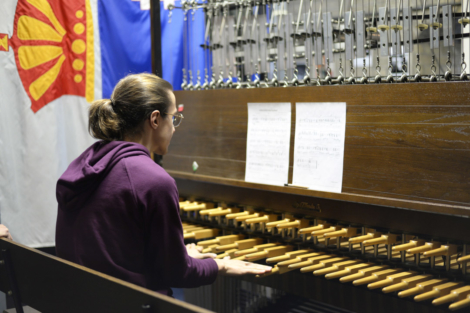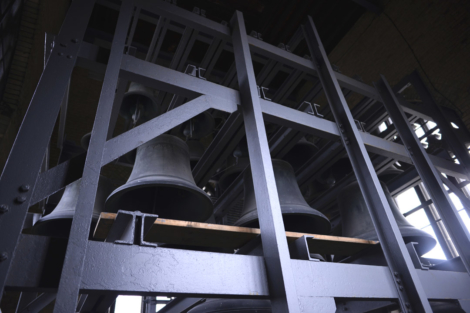To commemorate the sacrifices of the University of Toronto community during World War I, the university’s president, Sir Robert Falconer, called for the construction of a memorial in December 1918.
“It must be a beautiful structure,” he wrote in an article in the University of Toronto Monthly, “as fine as the architecture can make it, not too large, but a true memorial, worthy of the greatest event in the University’s history.”
Of the 5,308 staff, undergraduate, and graduate students who served in World War I, 12 per cent died while in service. The names of the 628 fallen have been engraved on the memorial tower, constructed from 1919 to 1924, with funds raised with the help of the Alumni Association in response to Falconer’s call.
The clock and carillon — the bells of the tower — were installed in 1927, and the music of the bells has become a centrepiece of the annual Service of Remembrance at U of T since 1924.
But the 51 bells of the tower are not played automatically — at the top of the tower, unseen each year by the people attending the service, a musician presses the keys of a piano-like instrument connected to the bells to create the music for the ceremony.
Learning to play the carillon
Mateusz Olechnowicz, a graduate student of mathematics at U of T, first became drawn to the music from the bells in November 2015, while singing at a Service of Remembrance in a choir.
“I heard the bells playing,” Olechnowicz said, “I say this as a joke, but this is actually what I thought: ‘Wow, I’d rather be up there, playing the bells, than down here freezing in the winter.’”
As it turns out, said Olechnowitcz with a smile, “it’s actually cold up here too.”
Soon after the service ended, Olechnowitcz contacted the administrator of the Soldiers’ Tower, Kathy Parks, to ask about taking lessons. He began lessons in February 2016 under carillon teacher and lawyer Roy Lee, and has continued practicing to this day. Explaining what drives his interest in the instrument, he said that “it’s challenging and exciting to play.”
“But it’s also very much about the sound — it’s unlike other instruments.”
“On the piano,” Olechnowitcz continued, “if you’re playing and you make a mistake, you just go again. Especially when you practice in your home. In private, no one is listening.” But the music from practicing with the bells of the Soldiers’ Tower can be heard for “quite a long radius.”
As the carillon is a percussion instrument, explained Olechnowitcz, the key part to a pleasing performance to listeners is “having a constant rhythm.”

“Constant rhythm” is the key to a pleasing performance of the carillon, said Mateusz Olechnowicz. ADAM LAM/THE VARSITY
“Halting and altering a rhythm is one of the worst things you can do,” he said, as people fall into step to a constant rhythm. According to Olechnowitcz, to “slow down or speed up” is the most noticeable mistake to an audience member — “so the sounds and notes you produce are not as important as [maintaining] the rhythm.”
The anatomy of a carillon
While the sounds from a carillon are distinctive, the layout of a carillon’s keyboard is comparable to a piano’s, explained Lee during a rare public tour of the Soldiers’ Tower.
“If you play piano or organ, you’ll recognize this keyboard set-up,” said Lee. He explained how two layers of batons act like keys – with “white keys on the bottom, black keys on top,” and a similar “pedal board” for operation by foot.
Each baton is wired to one of the 51 bronze bells at the top of the tower, which, as a whole, enables the carillonneur — the carillon player — to hit notes in a range of over four octaves. When a carillonneur presses down on a baton, explained Lee, a 500-pound free swinging metal ball called a clapper strikes the inside of the bell, sounding a note.
“The pedals down here,” added Lee, motioning toward the pedal board, “replicate the bottom half of the keyboard.” A musician can thus strike the same bell either by pressing on a baton on the keyboard’s bottom layer, or by pressing a foot pedal near the floor.
The carillonneur can also control how loudly each note is played. Due to the carillon’s mechanical design, explained Lee, how much force the carillonneur applies to each baton translates directly into how loudly each clapper strikes its bell. “If you just lightly tap it,” he continued, “it’s going to be a soft sound. If you really whack it then it’s going to be a thunderous sound.”
The challenges that carillonneurs face
Even if a musician tries to play the carillon softly, the massive size of the bells causes reverberations across campus. This is a drawback for carillon students, explained Lee.
Out of respect for students attending classes, carillon students spend most of their time playing on a practice carillon. In this layout, each baton connects to a rubber mallet that hits a pipe, rather than a clapper that hits a bell.
This causes a carillonneur to feel “very little resistance” when pressing the batons of a practice carillon, compared to “quite a bit of resistance” when pressing those of a performance carillon, explained Lee.
“Imagine if you’re learning how to play the violin, and you can only practice 15 minutes a day on it, or 15 minutes a week,” said Lee. “And if I give you this plastic replica that sort of looks like a violin and then I tell you to just pretend you’re playing it for the rest of the time.”
“The lack of playing time is probably the biggest challenge for students,” continued Lee. A limitation of practice time on the carillon is set by the university out of respect for the people living and taking classes around the Soldiers’ Tower.
Usually only two to four students can learn from Lee at a particular time, to account for the limited practice time available to the carillonneurs. To overcome this challenge, they also arrange to practice on the performance carillon at the Metropolitan United Church, explained Olechnowicz, and think of ways to improve performance while away from their instrument.
“You can think about how to play without actually playing,” said Olechnowicz. “You can read the music and think about what you’re going to do. Plan. Maybe you can schedule your practice time so that you make the most use of it.”
Coordination between hand and foot movement poses another challenge to successful performance, explained Naoko Tsujita, a percussionist who’s been a yearlong student of Lee.
“It’s really hard to coordinate my full body,” said Tsujita, explaining the difficulty of simultaneously playing with the keyboard and the pedalboard. “I’m still in the process of being able to use my feet naturally and smoothly.”
Olechnowicz also identified coordination as a challenge. “I would say it’s one of the most difficult instruments I’ve learned to play,” he said, “because there’s lots of practice and coordination involved.”
To increase the fluidity of her performance, Tsujita has “tried to play as many times as possible” over the past year, while also recognizing that improvement with the instrument is a “really, really slow process” that takes a great deal of practice time.
But to Tsujita, the process of improvement is time well spent. “I thought this is a really good exercise for me to train my body in awareness, in musical expression,” she said.
She has also found joy in the freedom of expression from using her hands to press the batons to create music from unseen bells above her. “They actually feel like they are very close and connected,” she said. “I can express what I feel through my hands, and tell the bells how to say it.”
Music and the freedom of expression
Scott Allan Orr, a U of T alum who composed a piece for the carillon named “everything that rises must converge” for the 2018 Service of Remembrance, also found music from the instrument to be a means to convey a message.
The inspiration for the composition arose from a conversation between Orr and Lee about the “various ways in which bells are interconnected with wars and memorials,” wrote Orr in an email to The Varsity.
As a consequence of the war effort in Europe, explained Orr, “many bells were plundered during WWI for their metal,” and also to reduce “their use for signalling and maintaining the [wartime] spirit of people who were in the vicinity of these bells.”
“In this way,” he continued, “the ringing of bells have an incredibly powerful memorial [effect] as ringing out freely [represents] peace and optimism for the future.”
“Having attended U of T as an undergrad,” wrote Orr, “it was also a way that I could give back to a community that meant a lot to me personally.”
Lee played the premiere of Orr’s piece from the Soldiers’ Tower during November’s Service of Remembrance during the post-lude of the ceremony, and was followed by his students playing solo pieces from several other composers.
The carillon and the community
The most important events that the carillonneurs play for, said Lee, are the Service of Remembrance and the bi-annual convocation
ceremonies, to celebrate the graduation of students at U of T.
“It’s something that really ties together the graduating classes,” added Lee. “If you think about it, the bells were installed in 1927, and every graduating class has heard those bells on their Graduation Day.”
“Shared musical experiences are rare now. You can only hear this sound by being in the neighbourhood, so it’s something that will stay with you for a long time,” he said, “and remind you of your time at U of T.”
As for the remainder of the carillonneurs’ performances in between, the songs that play from the bells create a “nice soundscape for the university.”
“Sometimes I’ll walk of the tower,” he continued, “and hear somebody humming [a tune] that I’ve just played.”
“That’s a neat feeling because you know you’ve made a difference in somebody’s day,” Lee said, “and they may not even be conscious of it.”



